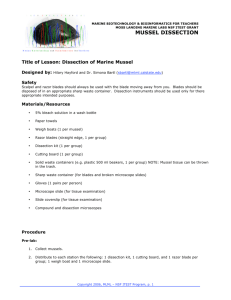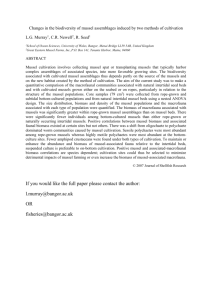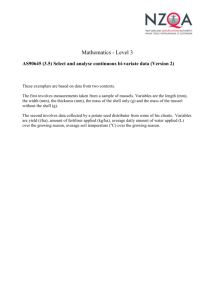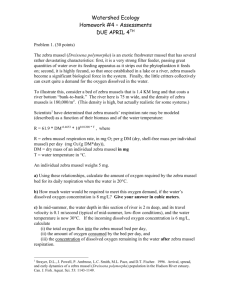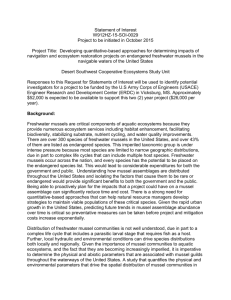MARINE BIOTECHNOLOGY & BIOINFORMATICS FOR TEACHERS
advertisement
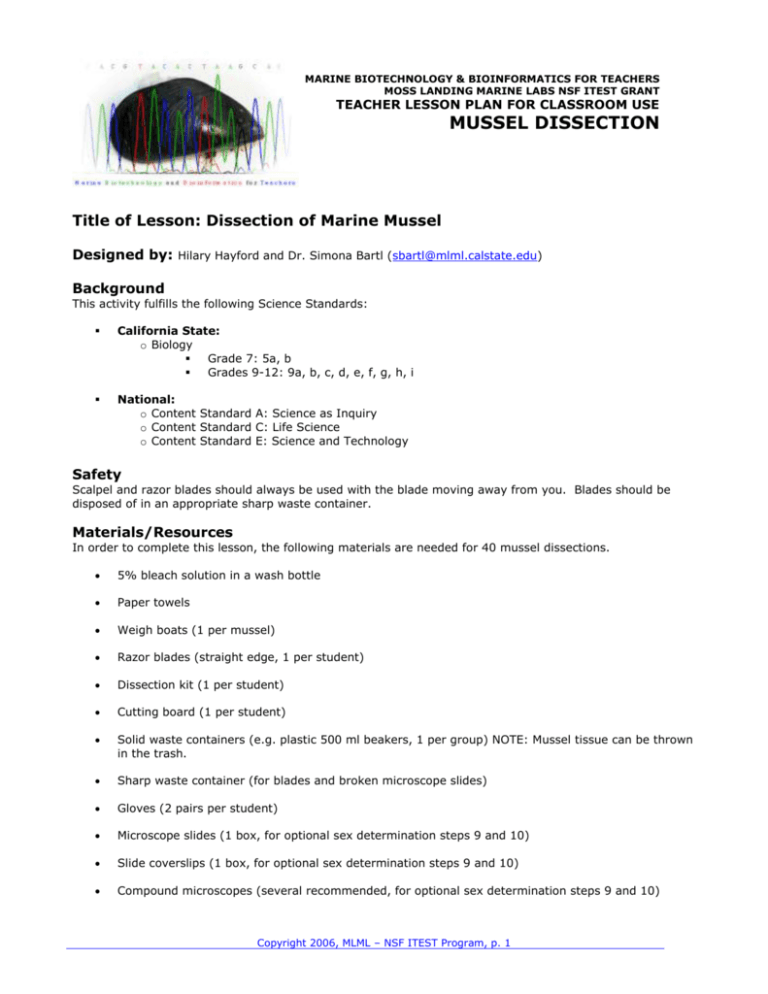
MARINE BIOTECHNOLOGY & BIOINFORMATICS FOR TEACHERS MOSS LANDING MARINE LABS NSF ITEST GRANT TEACHER LESSON PLAN FOR CLASSROOM USE MUSSEL DISSECTION Title of Lesson: Dissection of Marine Mussel Designed by: Hilary Hayford and Dr. Simona Bartl (sbartl@mlml.calstate.edu) Background This activity fulfills the following Science Standards: California State: o Biology Grade 7: 5a, b Grades 9-12: 9a, b, c, d, e, f, g, h, i National: o Content Standard A: Science as Inquiry o Content Standard C: Life Science o Content Standard E: Science and Technology Safety Scalpel and razor blades should always be used with the blade moving away from you. Blades should be disposed of in an appropriate sharp waste container. Materials/Resources In order to complete this lesson, the following materials are needed for 40 mussel dissections. 5% bleach solution in a wash bottle Paper towels Weigh boats (1 per mussel) Razor blades (straight edge, 1 per student) Dissection kit (1 per student) Cutting board (1 per student) Solid waste containers (e.g. plastic 500 ml beakers, 1 per group) NOTE: Mussel tissue can be thrown in the trash. Sharp waste container (for blades and broken microscope slides) Gloves (2 pairs per student) Microscope slides (1 box, for optional sex determination steps 9 and 10) Slide coverslips (1 box, for optional sex determination steps 9 and 10) Compound microscopes (several recommended, for optional sex determination steps 9 and 10) Copyright 2006, MLML – NSF ITEST Program, p. 1 Procedure Time needed for lesson Pre-lab: 30 minutes for 40 dissections, plus time to obtain mussel specimens Lab: one 50 minute period—the period can be used to dissect and begin DNA extraction on gill tissue or to complete a more in-depth dissection NOTE: To complete DNA extraction, see DNA Extraction protocol for additional pre-lab setup. If the lab will be conducted as a dissection only, skip steps 6 & 7 and see Additional Resources below. Pre-lab: 1. Collect or purchase mussels. Keep alive if possible, but can be frozen. 2. Distribute to each station the following: 1 dissection kit, 1 cutting board, and 1 razor blade per student; 1 weigh boat and 1 microscope slide per mussel sample. Lab: 1. Label each weigh boat with your letter and the sample number designation. If you will be extracting DNA, label sample tube at this time. 2. Place each mussel in a clean weigh boat so that it lies on one side, with the narrowest (anterior) part of the shell pointing towards you and the hinge on the left. The hinge is at the umbo (bent) part of the mussel shell. There may be byssal threads protruding from the opposite side. 3. Insert the corner of blade into the ventral opening opposite the hinge with sharp part of blade pointing away from you. Slice the posterior adductor muscle by moving the blade away from you and towards the wider (posterior) part of the mussel shell. Rock the blade back and forth as you work your way around the posterior end and down to the hinge. Repeat motion moving the blade from opening to hinge until the mussel is severed. You should be able to pull apart the shell valves with your hands once the mussel has been severed. If you have difficulty, a scalpel can be used in the same manner to reach further inside the mussel shell. 4. Once posterior adductor muscle has been severed, open mussel by pulling the two shell valves gently apart. Be gentle, but it is okay if you feel some tissue tearing as you open the mussel. 5. Locate the left and right gills of the mussel. The gills will be on either side of the central organs, lying along the mantle. (The mantle lines each shell valve.) They will be the length of the mussel, peach to beige, with visible striations. *** Steps 6 & 7 are to be completed if you plan to begin DNA extraction of mussel gill tissue. If no extractions are planned, skip to Step 8. 6. Using the forceps, pull off a small amount of gill tissue (about 3-4 rice grains worth) and add to your sample tube. Begin DNA extraction protocol. This step should be done within a few minutes of beginning dissection to avoid DNA degradation. (See DNA Extraction protocol.) 7. Wash razor blade, scalpel, forceps, and other tools with a 5% bleach solution and dry. Change gloves. These items must be sanitized to avoid contaminating the second mussel sample. 8. Repeat steps 2 through 8 with the second mussel. Copyright 2006, MLML – NSF ITEST Program, p. 2 9. For each mussel, find the reproductive tissue (invading the mantle) of the mussel between the gill filaments and the inside of the shell. In some cases the gonad found here might not be mature, in which case you should attempt to locate the gonopore region in the posterior portion of the visceral mass. If you have difficulty determining the gender under the microscope, make a squash from the gonopore region. 10. Make a squash by pinching a small amount (about the size of a pencil tip) of gonad tissue onto a microscope slide. Spread the tissue thinly over the slide and place the coverslip over the tissue, pressing firmly. Use a compound microscope to look for sperm or eggs. As a general rule, mature male tissue will be white to peach in color and mature female tissue will be orange to yellow. Under the microscope, look for oocytes denoting female tissue. These will be round globules that are about 100X larger than the round spermatocytes. Oocytes will be visible using the 4X objective, while spermatocytes will be visible at 40X. If you see squiggly motion these are likely sperm. 11. Scrape the remaining tissue out of the left valve of the mussel. Clean and dry the shell. 12. Examine the interior of the shell to verify that you have dissected a Bay mussel. Bay mussels have a shortened and widened posterior adductor/foot retractor scar; anterior adductor is toward ventral shell edge. California mussels have an elongated and narrowed posterior adductor/foot retractor scar; anterior adductor is centered. See Mussel Collection and Dissection presentation for more information. 13. Using a permanent marker, label left valve (shell) from each mussel with your letter and sample number and date, and keep for future reference. 14. Measure the length of shell (in centimeters) from the anterior end to the furthest point of the posterior end. Record longest measurement. View of left valve containing all tissues: Dorsal Gill Posterior Gonad Gonopore region Anterior Ventral Copyright 2006, MLML – NSF ITEST Program, p. 3 Additonal Resources: Recommended references for dissection of additional bivalve body systems Diversity of The Invertebrates: A Laboratory Manual Pacific Coast Version, by James W. Nybakken UCSC Invertebrate Zoology Bivalve Dissection Lab Manual http://bio.classes.ucsc.edu/bio136/LabManual/MytilusVenus.pdf Lander University Invertebrate Zoology Mytilus edulis Dissection Lab Manual http://www.lander.edu/RSfox/310mytilusLab.html Copyright 2006, MLML – NSF ITEST Program, p. 4
